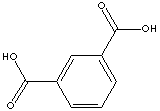ISOPHTHALIC ACID
GENERAL
PHYSICAL PROPERTY & DESCRIPTION
CAS NO.
STRUCTURE
Appearance And Odor: Crystals. White.Ph: Not Determined.
Vapor Pressure: Not Determined.
Vapor Density: Not Determined.
Boiling Point: 212°F(100°C) (Sublimes)
Melting Point: 656°F(347°C)
Solubility In Water: Not Determined.
Specific Gravity (Water=1): 1.54
121-91-5

SYNONYM
IPA
Mol Wt.
C8H6O4
166.13
PRECAUTION IN HANDLING
Take appropriate measures to prevent static discharges, which may include thorough electrical interconnecting, grounding of equipment, and/or conveyance under inert gas.
APPLICATION
Isophthalic acid is a key ingredient in FRP markets for such products as marine, automotive, and corrosion resistant pipes and tanks. Polyesters containing PIA are also used extensively in industrial coatings applications for home appliances, automobiles, aluminum siding, and metal office furniture.
SPECIFICATION
|
Acid Number |
mgKOH/g |
675±2 |
|
Moisture |
wt% |
0.08 max |
|
Isophthalic Acid |
wt% |
99.8 min |
|
3-CBA |
ppm |
5 max |
|
M-Toluic Acid |
ppm |
50 max |
|
Ash |
ppm |
3 max |
|
Total Metal |
ppm |
3 max |
OTHER INFORMATION